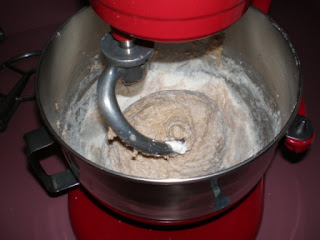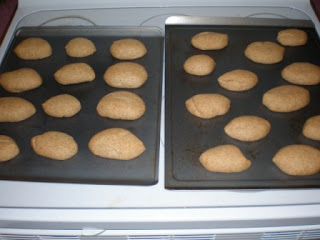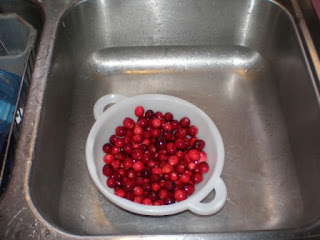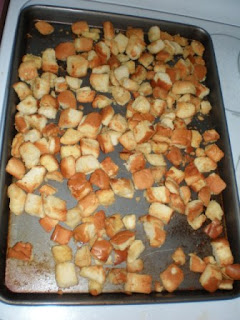
A few days ago I posted about
homemade hot chocolate mix. I love to put marshmallows in my hot chocolate. One big, giant one. That got me thinking, how hard is it to make your own marshmallows?
I’ve actually investigated this before briefly. What I found was a Martha Stewart recipe involving candy thermometers. At the time it seemed a little too complicated for me.
The other day I found what appeared to be a much simpler recipe on
Slashfood. Although I was still a bit intimated, I decided to give it a whirl! The recipe is as follows:
Homemade MarshmallowsApproximately 40 large marshmallows0.75 oz unflavored gelatin (3 envelopes of Knox gelatin)
½ cup cold water
2 cups granulated sugar
2/3 cup light corn syrup
¼ cup water
¼ teaspoon salt
1 tablespoon vanilla extract
Line a 9x9 inch pan with plastic wrap and lightly oil. Set aside. In the bowl of an electric stand mixer, sprinkle gelatin over ½ cup cold water. Soak for about 10 minutes.
Meanwhile, combine sugar, corn syrup and ¼ cup water in a small saucepan. Bring the mixture to a rapid boil and boil hard for 1 minute. Pour the boiling syrup into the soaked gelatin and turn on the mixer, using the whisk attachment, to high speed. Add the salt and beat for 12 minutes. After 12 minutes, add the vanilla extract and beat to incorporate. Scrape marshmallow into the prepared pan and spread evenly (grease the spatula or your hands). Take another piece of lightly oiled plastic wrap and press lightly on top of the marshmallow, creating a seal. Let mixture sit for a few hours, or overnight, until cooled and firmly set.
In a shallow dish, combine equal parts cornstarch and confectioner’s sugar. Remove marshmallow from the pan and cut into equal pieces with scissors or a chef’s knife. Dredge each piece of marshmallow in the confectioner’s sugar mixture. Store in an airtight container.
Ok seems simple enough. I start by gathering the ingredients:

Then I put the ½ cup cold water into my mixing bowl and then pour three packs of the gelatin over the top of it. I do not stir it up.

In my saucepan I add the sugar, corn syrup and ¼ cup cold water. Tip: when measuring sticky ingredients like honey, molasses or corn syrup, spray the inside of the measuring cup with non-stick spray first. The sticky ingredient will slide right out.

I flip the heat on the burner to high and start stirring it all up. Once everything is mixed up I leave it alone to prepare my pan. I do not have a 9x9 pan so I use my 8x8 pan. I put two layers of plastic wrap on the inside (one going each way) and then spray it down with non-stick spray.

Back to my saucepan. I stir the ingredients frequently and they come to a boil rather quickly. I set my kitchen timer for a minute and let the liquid boil rapidly.

Once the timer goes off I immediately dump the liquid into my mixer bowl on top of the gelatin and snap it onto my mixer. I put on the whisk attachment, raise the bowl and flip it to a high speed. Steam starts pouring out of the mixer bowl. Hahahaha. It looks like some sort of special effect. I quickly measure and toss in the salt while the mixer is running.

Now I set my timer for 12 minutes and wait. Now is a good time to clean up your kitchen! Here is what the mixture looked like as it was mixing:


Once 12 minutes were up the mixture had grown a lot and was shiny and white. Out of paranoia I gave my pan another little squirt of non stick spray, then I sprayed my spatula and proceeded to scrape the marshmallow mixture out of the bowl and into my pan. It comes out fairly easily and fills the pan up to the top. Not much spreading is actually needed.

I place the last piece of oiled plastic wrap across the top and seal. I set this aside to set overnight. Then I had to lick the spatula and sure enough, it tastes like marshmallow fluff! Mmmmm.
Now this bowl looks like it’s going to be a huge pain to clean, but it actually wasn’t. Give it 10 minute soak in super hot water and all the marshmallow stickiness will melt away.

The next afternoon I am ready for the next step. I remove the top layer of plastic wrap and then lift out the entire slab of marshmallow onto my cutting board. I peel off the plastic wrap from the bottom of the marshmallow square. The marshmallow slab is kind of sticky, but it pulls away from whatever it gets stuck to pretty easily.

Okay, now for the cutting. The directions said to use scissors but for some reason I think a knife will work better. Wrong! I try to cut it with the biggest knife I have and it barely leaves a dent. The marshmallow just springs back into place. Okay I guess I’m using my kitchen shears. I cut the slab into strips, then cut the strips into chunks, then cut each chunk in half to make cubes.

To keep from sticking to each other, the marshmallows must be dredged in a corn starch and confectioner’s sugar mixture. The directions say to use equal parts so I mix up two tablespoons of each in a little bowl. I dredge each marshmallow in the powdery mixture and then toss them into a big plastic container.

I do the whole process of cutting and dredging in batches and it takes a little while to get through them all. I end up with quite a few marshmallows in the end! I tasted one and they taste pretty darn good!

Overall I think these were easy and fun to make. I think you pretty much have to have a stand mixer though. Mixing up the marshmallow batter was super simple. The cutting and the dredging part took awhile but was not difficult.
Next time I will use a larger pan so that the marshmallow slab is not as thick. I think this will make the cutting process easier and faster.
The comments on
Slashfood for this recipe had a lot of great suggestions for modifications such as using mint extract instead of vanilla or rolling the marshmallows in chopped up nuts or cookies for extra flavor. I also read that it is possible to spread the marshmallow batter in a jelly roll pan and then use cookie cutters to cut marshmallows into fun shapes.
I don’t know if I will make homemade marshmallows all the time, but they are definitely fun for special occasions and holidays. Pair a jar of homemade marshmallows with a jar of
homemade hot chocolate mix as a gift for a friend or family member this holiday season.




































